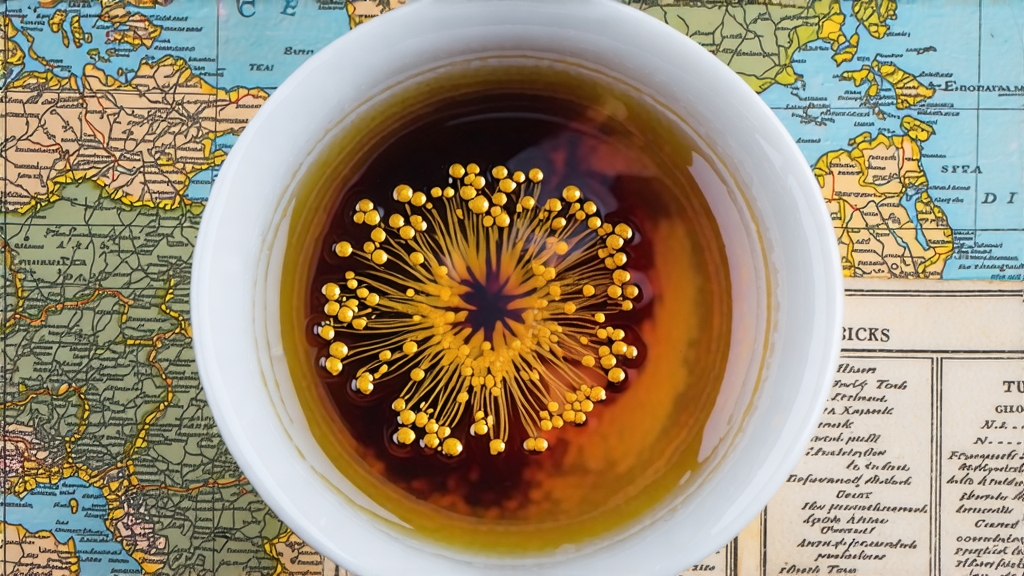
Among the six great families of Chinese tea, dark tea—hei cha—remains the least explored beyond China’s borders, yet it once served as de-facto currency along the Silk Road. Within this shadowy category, Fu Brick (Fú zhuān chá) stands out: a brick-shaped tea that deliberately invites a microorganism to bloom inside its compressed leaves, creating tiny golden spots nicknamed “golden flowers.” These flowers are not ornamental; they are living proof of a 1,300-year-old post-fermentation craft that turns rough Hunan summer leaf into a mellow, malty liquor prized by nomadic empires and modern sommeliers alike.
Historical caravans carried Fu Brick from the humid lake lands of Hunan to the wind-scoured plateaus of Tibet and Mongolia. There, butter, salt and milk were whipped into the brew, yielding a calorie-rich soup that countered altitude sickness and sub-zero winters. Imperial edicts during the Ming dynasty (1368-1644) codified its trade value: one Fu Brick of 1.6 kg equaled one bolt of silk or two sheep. The bricks were so hard that caravaners used them as stools at night and drink by day. Archaeological digs along the Hexi Corridor still uncover intact bricks stamped with the same government trademarks used in 1640.
Fu Brick begins life as raw dark tea (mao cha) harvested in late May from the large-leaf Yuntaishan cultivar. Leaves are withered under Hunan’s mountain mist, then pan-fired at 280 °C for eight minutes to arrest oxidation. While still warm, they are rolled for 45 minutes to rupture cell walls, encouraging the later microbial feast. A 12-hour pile-fermentation follows: leaves are heaped 70 cm high, sprayed to 28 % moisture, and covered with hemp cloth. Thermophilic bacteria push the pile to 55 °C, softening the leaf and fixing the dark color. What distinguishes Fu Brick from other hei cha is the next step—brick pressing and flowering. The fermented leaf is steamed for 30 seconds, then tipped into 1.6 kg wooden molds lined with cotton paper. Hydraulic presses exert 80 bar for 20 minutes, creating a dense block that retains just enough air channels. The bricks are stacked inside a 28 °C “flowering room” (fā huā shì) where humidity hovers at 75 %. Over 15–20 days, spores of Eurotium cristatum—naturally present in the wooden rafters—colonize the moist leaf, producing yellow cleistothecia visible to the naked eye. These golden flowers secrete enzymes that further degrade tannins and starch, converting bitter catechins into smooth theabrownins and aromatic 2-acetyl-pyrrole, the molecule that smells like roasted peanuts. Once the bloom reaches 50,000–100,000 colonies per gram, the bricks are moved to low-humidity warehouses and aged for a minimum of three years; vintage lots from 1998 now fetch 3,000 USD per brick at auction in Guangzhou.
Western drinkers often confuse Fu Brick with Pu-erh. Both are post-fermented, yet their microbiology diverges. Pu-erh relies on Aspergillus niger and yeasts such as Blastobotrys adeninivorans, whereas Fu Brick is dominated by Eurotium cristatum, the same fungus used in Japanese koji. The result is a cup that is less leathery than ripe Pu-erh, more honeyed, with a lingering note of dried apricot and wet pine bark. Laboratory tests at Hunan Agricultural University show that Fu Brick contains statistically higher levels of cyclo-(Leu-Pro), a diketopiperazine that activates umami receptors, explaining the tea’s broth-like mouthfeel.
To brew Fu Brick gongfu style, begin by prying off 5 g from the corner of the brick—never the center, where compression is tightest. Use a stainless-steel pick warmed over a candle to prevent cracking the leaf. Rinse the flake quickly with 100 °C water, then steep in a 120 ml Yixing teapot that has previously seasoned only dark teas. First infusion: 15 s, discard; this awakens the flowers. Second infusion: 95 °C for 10 s, yielding a cognac-orange liquor. Third to fifth infusions: add 5 s each;